Artillery in the United Kingdom
Artillery in the United Kingdom
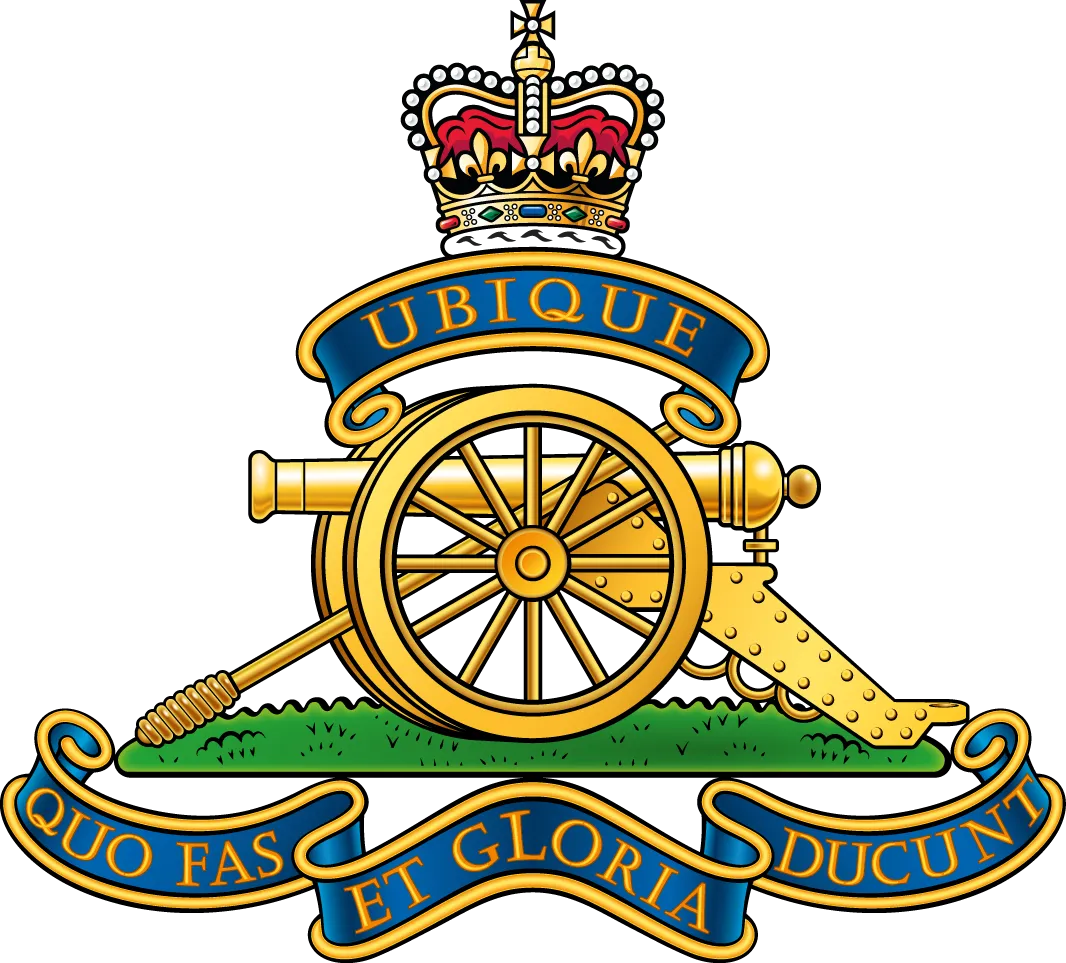
The Royal Regiment of Artillery, commonly referred to as the Royal Artillery (RA) and colloquially known as "The Gunners", is one of two[b] regiments that make up the artillery arm of the British Army. The Royal Regiment of Artillery comprises thirteen Regular Army regiments, the King's Troop Royal Horse Artillery and five Army Reserve regiments.
Artillery was used by English troops as early as the Battle of Crécy in 1346, while Henry VIII established it as a semi-permanent function in the 16th century. Until the British Civil Wars, the majority of military units in Britain were raised for specific campaigns and disbanded when they were over.[6] An exception were gunners based at the Tower of London, Portsmouth and other forts around Britain, who were controlled by the Ordnance Office and stored and maintained equipment and provided personnel for field artillery 'traynes' that were organised as needed.
These personnel, responsible in peacetime for maintaining the forts with their garrison artillery (or coastal artillery), were the first regular artillerymen, organised in 1540 under the Master-General and Board of Ordnance, but paid directly by the Exchequer. The regular artillerymen of the District Establishments were responsible for upkeep of the fort and maintenance of equipment, and would be brought up to strength in wartime with untrained personnel drafted in from the British Army or the Militia. The post of Captain of Fort was replaced (at least in England, if not in its colonies) with that of Governor following the Restoration. When Marlborough was restored as Master-General of the Ordnance in 1714, he initiated a series of reforms, which included splitting the existing Ordnance Service into artillery and sappers or engineers. The artillery were formed into two marching companies, each of 100 men, in 1716.
These marching companies were renamed the "Royal Artillery" in 1720. These were increased to four companies and on 1 April 1722 grouped with independent artillery units at Gibraltar and Menorca to form the Royal Regiment of Artillery; the first commander was Colonel Albert Borgard, a Dane who served in the British army since 1698.
Aside from the Master Gunner of England, the detachments in each fort formed a District Establishment that included a Captain of Fort, a Master-Gunner or Chief-Gunner, and a number of other ranks, including Gunners, Gunner's Mates, Quarter-Gunners, and Matroses. Their numbers were extremely small; as late as 1720, the total establishment for the whole of Britain was 41 master gunners and 178 gunner assistants. Although the Royal Artillery increasingly involved itself with the coastal artillery in Britain, also, the District Establishments remained independent until February 1771, when the Royal Artillery formed eight Invalid Companies (made up of personnel no longer fit for expeditionary service) into which they were absorbed (although the District Establishments would still rely on drafts of sailors, British Army soldiers, Militia infantrymen, or Volunteers to bring the batteries up to wartime strength until the formation of Militia Artillery and Volunteer Artillery in the 1850s).
During the 18th century, the British regular military forces, including the Board of Ordnance's military corps (the Royal Artillery, Royal Engineers and later the Royal Sappers and Miners) and the British Army (composed mostly of infantry and cavalry) became increasingly professional (various reserve, or local, forces also existed, including: the Militia, or old Constitutional Force, normally made up of infantry units; the mounted Yeomanry; and Volunteer units of various types, normally raised only during wartime), particularly in the fields of artillery and engineering; Britain lagged behind others in this area, with Vauban establishing the French Corps royal des ingénieurs militaires as far back as 1690.
A cadet company was formed at the Royal Military Academy or RMA Woolwich in 1741; this trained artillery and engineering officers for the regiment, the East India Company and the Royal Irish Artillery.[5] In 1757, it split into two battalions, each of twelve companies; by 1780, it contained 32 companies in four battalions, two "invalid companies" used solely for garrison duties and the Royal Artillery Band, with a total strength of 5,241 men and officers.
Originally based in the Royal Arsenal, beginning in 1770 the regiment was rehoused in the Royal Artillery Barracks on Woolwich Common. A major innovation in 1793 was the establishment of the Royal Horse Artillery, designed to provide mobile fire support for cavalry units. The same year saw the foundation of the Corps of Royal Artillery Drivers to provide transport for the artillery.
Fixed Coastal Artillery batteries were generally manned in peacetime by a handful of Royal Artillery personnel primarily responsible for maintenance, who were reinforced in wartime by drafts of infantrymen from the British Army or the Militia, or by temporarily-raised Volunteer Artillery corps. This was to remain the case through the Naploeonic Wars.
The regiment was involved in all major campaigns of the Napoleonic Wars; in 1804, naval artillery was transferred to the Royal Marine Artillery, while the Royal Irish Artillery lost its separate status in 1810 after the 1800 Union. This period also saw development of the Congreve rocket; based on an existing Indian design, these were the first solid-fuel projectiles used by the British army and two rocket troops were established in 1814. Their use in the War of 1812 is referenced in the line "rocket's red glare" which appears in the Star-Spangled Banner.
The Militia, which had been a paper tiger since the end of the Napoleonic Wars, was re-organised under the Militia Act 1852 in response to the threat of invasion by France, changing it from a conscripted force to one made up of volunteers who engaged for terms of service. The force continued to be a reserve tasked with home defence, embodied for annual training, and for the duration of wars or emergencies. The Militia had been principally an infantry force to this date, but Militia Artillery units were added from this point, and some existing Militia Infantry regiments were converted to coastal artillery. The role of the Militia Artillery was to man coastal defences and fortifications in wartime, relieving the Royal Artillery (RA) for active service.
The Royal Artillery (and also of the Royal Engineers, Royal Sappers and Miners, the Commissariat Department, and various barracks, ordnance stores, and transport departments) was transferred to the British Army when the Board of Ordnance was abolished in 1855 (the administrative branches of the Board were absorbed by the War Office) and the War Office School of Gunnery established in Shoeburyness in 1859. When the British East India Company was dissolved in 1862, its artillery function was absorbed by the Royal Artillery, giving it a total strength of 29 horse batteries, 73 field batteries and 88 heavy batteries. Military expenditure estimates for 1872 list the regimental strength as a total of 34,943 men and officers, including those in India.
Although the Militia and the Volunteer Force remained separate forces, during the latter half of the Nineteenth Century they were re-organised through a succession of reforms, and increasingly integrated with the British Army. In 1882, the Militia Artillery units lost their individual identities, becoming numbered brigades organised within Royal Artillery territorial divisions (two brigades of horse artillery, four brigades of field artillery and eleven territorial divisions of garrison artillery). In 1889 the number of divisions was reduced to three, and the Militia Artillery brigades were renamed again, mostly regaining some variation of their original territorial names.
Post 1881, militia artillery officers wore for a brief time five button serge foreign service frocks with ball buttons and silver lace. Post 1890, officers transitioned to pocketed examples, again with ball buttons but the frocks varying from pure blue serge to other examples with scarlet facings.
Prior to 1882, each Militia Artillery unit in the United Kingdom wore a unique badge. Between 1882 and 1889, Militia Artillery brigades wore a divisional badge based on that of the Royal Artillery, except that the lower scroll and upper scroll, which on the Royal Artillery badge were inscribed "Quo Fas Et Gloria Ducunt" and "Ubique" (which indicated the regular Royal Artillery, like the Royal Engineers, served everywhere), were respectively inscribed with the name of the territorial division name (by example, North Irish Division) and left blank or covered in a spray of laurel (as the Militia and Volunteer Force were both home defence forces, the members of which could not be sent abroad on expedition without their consents). From 1889 to 1902, the lower scroll was inscribed with the name of the unit (by example, Antrim Artillery) and the upper scroll left blank or covered in a spray of laurel. Grenade badges, whether worn as a collar badge or elsewhere, lacked the scroll inscribed "Ubique" that was part of the regular Royal Artillery version. Militia Artillery units were made up of Militia officers and other ranks, with a Permanent Staff made up of seconded Royal Artillery officers and senior other ranks, including a single officer acting as both Commandant and Adjutant (where a suitably qualified Militia officer was unavailable to serve as Commandant), or only as Adjutant where the Commandant was a Militia officer. Units from the Royal Engineers and Royal Artillery were in Australia, even after Federation. (Wikipedia)
On 1 July 1899, the Royal Artillery was divided into three groups: the Royal Horse Artillery of 21 batteries and the Royal Field Artillery of 95 batteries composed one group, while the coastal defence, mountain, siege and heavy batteries were split off into another group named the Royal Garrison Artillery of 91 companies.[5] The third group continued to be titled simply Royal Artillery, and was responsible for ammunition storage and supply. Which branch a gunner belonged to was indicated by metal shoulder titles (R.A., R.F.A., R.H.A., or R.G.A.). The RFA and RHA also dressed as mounted men, whereas the RGA dressed like foot soldiers. In 1920 the rank of Bombardier was instituted in the Royal Artillery.
Following the separation of the regular garrison companies into the Royal Garrison Artillery in 1899, the Militia Artillery units were re-titled accordingly in 1902 (by example, The Antrim Royal Garrison Artillery (Militia), which would usually be rendered Antrim R.G.A (M)). The badge adopted was the same as that of the regular Royal Regiment of Artillery, from that point including the "ubique" and "Quo Fas Et Gloria Ducunt" scrolls, with a letter "M" fixed at the bottom of the gun badge, and on the body of the grenade on the grenade badge (also with the "ubique" scroll), whether worn on the collar or on a cap. Alternately, Ubique was replaced on scrolls with the name of the city, county or colony for which the unit was named.
When the Volunteer Force and the Yeomanry in the United Kingdom (including the Volunteer Artillery) were merged to create the Territorial Force in 1908, the Militia was re-designated the Special Reserve. At the same time, plans were made to convert all of the Royal Garrison Artillery (Militia) units to Special Reserve Royal Field Artillery, but all Home units other than The Antrim Royal Garrison Artillery (Militia) (converted in 1956 to 74 (Antrim Artillery) Engineer Regiment (V)) were instead disbanded in 1909 (although Militia Artillery units remained in some of the colonies, and these were not re-designated as Special Reserve; The most notable of these was the Bermuda Militia Artillery, which, like the Bermuda Volunteer Rifle Corps, formed part of the garrison of the important Imperial fortress colony of Bermuda where the regular Royal Artillery had first posted a company in 1794, following the French Revolution). The remainder of the Special Reserve was re-designated as the Militia again after the First World War and permanently suspended. The Territorial Force was renamed the Territorial Army.
The division of the Royal Regiment of Artillery lasted until 1924, when the RFA, RHA, and RGA amalgamated once more to become one regiment. In 1938, RA Brigades were renamed regiments. During the Second World War there were over 1 million men serving in 960 gunner regiments. In 1947 the Riding Troop RHA was renamed the King's Troop Royal Horse Artillery[38] and, in 1951, the title of the regiment's colonel-in-chief became Captain General.[5] When The Queen first visited the Troop after her accession, it was expected that it would become "The Queen's Troop", but Her Majesty announced that in honour of her father's decision it would remain "The King's Troop".
The Royal Horse Artillery, which has separate traditions, uniforms and insignia, still retains a distinct identity within the regiment. Before the Second World War, Royal Artillery recruits were required to be at least 5 feet 4 inches (1.63 m) tall. Men in mechanised units had to be at least 5 feet 8 inches (1.73 m) tall. They initially enlisted for six years with the colours and a further six years with the reserve or four years and eight years. They trained at the Royal Artillery Depot in Woolwich.
From its beginnings, the Royal Artillery has been based at Woolwich, in south-east London. In 2003 it was decided to move the headquarters to Larkhill in the Salisbury Plain Training Area in Wiltshire (the RA's training ground, where the Royal School of Artillery has been based since 1915). In 2012, however, the King's Troop, Royal Horse Artillery was relocated to Woolwich from their former headquarters in St John's Wood.
The Royal Artillery is equipped with a variety of equipment and performs a wide range of roles, including: Surveillance and target acquisition/unmanned air systems; Commando and airborne artillery; Self-propelled artillery; Multiple launch rocket systems; Air defence.
The Captain General of the regiment is King Charles III. The post was previously known as Colonel-in-Chief until King George VI expressed the desire to be known as Captain General. The head of the regiment is the Master Gunner, St. James's Park.
The Royal Regiment of Artillery comprises both Regular (full-time) and Reserve (part-time) units. The Royal Regiment of Artillery is unusual in that it has sub-units that often move between regiments, or are placed into suspended animation. (Wikipedia)
The Royal Regiment of Artillery comprisesone ceremonial troop and 13 Regular Army regiments, and are designated by a number and the name Royal Artillery (RA) or Royal Horse Artillery (RHA):
Regular regiments of the Royal Horse Artillery
The King's Troop, Royal Horse Artillery – His Majesty's Mounted CeremonialBattery. A ceremonial unit equipped with 13 pounder guns for the firing ofRoyal Salutes. Now located in Woolwich Garrison.
1st Regiment Royal Horse Artillery – based in Larkhill Garrison.
3rd Regiment Royal Horse Artillery – (The Liverpool and Manchester Gunners) are equipped with Multiple Launch Rocket System (MLRS) based at Albemarle Barracksoutside Newcastle-Upon-Tyne.
7th Parachute Regiment Royal Horse Artillery – (The Airborne Gunners) are equipped with L118 105 mm light guns and are currently held at Very HighReadiness, as part of 16th Air Assault Brigade, based at Merville Barracks,Colchester.
Regular regiments of the Royal Artillery
4 Regiment Royal Artillery – (The North East Gunners) are equipped with L118105 mm light guns at Alanbrooke Barracks in Topcliffe.
5 Regiment Royal Artillery – (The Yorkshire Gunners) are equipped withSurveillance and Target Acquisition assets and are based at Marne Barracks inCatterick, North Yorkshire.
12 Regiment Royal Artillery – (The Lancashire and Cumbrian Gunners) are theArmy's Close Support Air Defence unit equipped with Starstreak HVM on the SelfPropelled HVM Stormer armoured vehicle and are based at Baker Barracks, ThorneyIsland.
14 Regiment Royal Artillery – are the Training and Support Regiment based atStirling Barracks in Larkhill Garrison.
16 Regiment Royal Artillery – (The London Invicta Gunners) are the Army'sMedium Range Air Defence unit equipped with Sky Sabre and are based at BakerBarracks, Thorney Island.
19 Regiment Royal Artillery – (The Scottish Gunners) are equipped with ARCHERWheeled self-propelled howitzer, and MSTAR radar at Larkhill Garrison.
26 Regiment Royal Artillery – (The West Midland Gunners) are equipped withMultiple Launch Rocket System (MLRS) and Exactor 2 at Larkhill Garrison.
29 Commando Regiment Royal Artillery – (The Commando Gunners) are equipped withthe L118 105 mm light gun, and are currently part of UK Commando Force. Mostbatteries are currently based at the Royal Citadel, Plymouth, with one battery(148 (Meiktila) Battery) based at RM Poole and 7 (Sphinx) Battery based at RM Condor, Arbroath.
32 Regiment Royal Artillery – (The Wessex Gunners) are equipped with UnmannedAerial Systems and are based in Roberts Barracks in Larkhill.
47 Regiment Royal Artillery – (The Hampshire and Sussex Gunners) – are equipped with Unmanned Aerial Systems and are based in Horne Barracks in Larkhill.
Army Reserve
100th (Yeomanry) Regiment Royal Artillery – A specialist pool of gunneryinstructors, naval gunfire liaison officers, forward air controllers andpersonnel supporting formation headquarters in the Army, all divisions and most brigades.[57] Based at Royal Artillery Barracks, Woolwich Garrison with batteriesin Larkhill Garrison and Bath.
101 (Northumbrian) Regiment Royal Artillery – Equipped with Multiple LaunchRocket System (MLRS) and paired with 26 Regiment RA. Has batteries inGateshead, Blyth, Newcastle, Hexham, South Shields, Catterick, and Leeds.
103 (Lancashire Artillery Volunteers) Regiment Royal Artillery – Equipped with L118 light gun. Has batteries in St Helens, Bolton, Liverpool, Manchester,Bulwell, and Wolverhampton
104 Regiment Royal Artillery – Equipped with the L118 light gun. Has batteriesin Newport, Abertillery, Bristol, Worcester, and Plymouth.
105 Regiment Royal Artillery – (The Scottish & Ulster Gunners) – Equippedwith the L118 light gun. Has batteries in Edinburgh, Newtownards, Coleraine,Glasgow, Arbroath, Kirkcaldy, Shetland, and Livingston.
106 (Yeomanry) Regiment Royal Artillery – The Army's only Reserve Air Defenceunit. Equipped with the Starstreak missile and currently a part of 7th AirDefence Group, with batteries in Grove Park, Portsmouth, and Southampton.
Equipment
Air defence
The Royal Artillery utilises two air defence weapons:
Sky Sabre - Operated by the 7th Air Defence Group since 2021, replacingRapier. This system consists of Land Ceptor missiles, SAAB Giraffe AMBradars and Rafael Advanced Defense Systems Modular Integrated C4I Air &Missile Defense System (MIC4AD), all mounted on MAN trucks.
Starstreak HVM – Starstreak HVM is a very short range air defence (VSHORAD)system that is a continuation of the Blowpipe and Javelin series. It is operatedas either a shoulder-launched weapon, in the lightweight multiple launchermode, or mounted on the Alvis Stormer armoured vehicle. The weapon is operatedby 12 Regiment RA and 106 Regiment RA.
Close support artillery
The Royal Artillery field the following close support/offensive supportweapons:
M270 MLRS – The multiple launch rocket system provides a precision firecapability out to 150km with the Guided MLRS Extended Range (GMLRS-ER)missile.[66] Operated by 26 Regiment RA and 101 Regiment RA, and 3 RegimentRHA, which reroled in 2023 to the MLRS.
L118 light gun – The light gun is a 105 mm gun. It is operated by 4th RegimentRA, 7th (Para) Regiment RHA, 29 (Commando) Regt RA, as well as three ArmyReserve regiments – 103 Regiment RA, 104 Regiment RA and 105 Regiment RA.
Exactor (Spike NLOS) – A vehicle-mounted high-precision guided missile. It iscurrently solely operated by 26th Regiment RA since 2020.[68]
Archer – Deal with Sweden announced on 16 March 2023 to replace part of the 32AS-90 transferred to Ukraine, systems operational from April 2023. It is aninterim replacement before RCH 155 reaches full operational capability (FOC) in2030.[69][70]
RCH 155 – Future self propelled howitzer mounted on a Boxer MIV, to be inservice by the end of the decade and will replace the AS-90.
Intelligence, surveillance, target acquisition and reconnaissance (ISTAR)
TAIPAN – Replacing MAMBA – is an artillery hunting radar that is used by 5thRegiment RA for counter-battery operations, locating an increased number oftargets at greater range with reduced electronic warfare signatures.[73][74]
ASP (advanced sound-ranging program) – is an acoustic triangulation system thatused a series of sensor posts (microphones) to triangulate the point of originand point of impact of enemy mortars and artillery. It is operated by 5thRegiment RA.
Desert Hawk III UAV – the DH3 is a hand-launched UAV. It is operated by 32Regiment RA.
Ceremonial
13 pounder – The King's Troop, Royal Horse Artillery retains six operationalFirst World War-era QF 13 pounders for use as state saluting guns. (Wikipedia)
In the British Army Order of Precedence, the Household Cavalry is always listed first and always parades at the extreme right of the line. However, when the Royal Horse Artillery is on parade with its guns it will replace the Household Cavalry at the extreme right of the line.
Preserved artillery in the United Kingdom
Several locations in England preserve historical artillery pieces. The Royal Artillery Museum, formerly in Woolwich, now operates from interim premises while planning a new museum at Larkhill, showcasing a vast collection of artillery from various eras. Additionally, the Dover Strait coastal guns, a series of Second World War batteries, are preserved along the Kent coast, demonstrating the long-range coastal artillery used during that period. The Royal Artillery Memorial in London also features artillery pieces and is maintained by English Heritage.
The Royal Artillery Museum
The Royal Artillery Museum, which was one of the world's oldest military museums, was first opened to the public in Woolwich in southeast London in 1820. It told the story of the development of artillery through the ages by way of a collection of artillery pieces from across the centuries. The museum had its roots in an earlier institution, the Royal Military Repository (established in Woolwich in the 1770s as a training collection for cadets of the Royal Military Academy); items which were once displayed in the Repository form the nucleus of the Royal Artillery Museum collection. Following the closure in 2016 of the museum, branded since 2001 as 'Firepower – The Royal Artillery Museum', its collection has been placed in storage pending the establishment of a new Royal Artillery Museum. The Royal Artillery Museum collections are designated as being of national and international significance by Arts Council England. (Wikipedia)
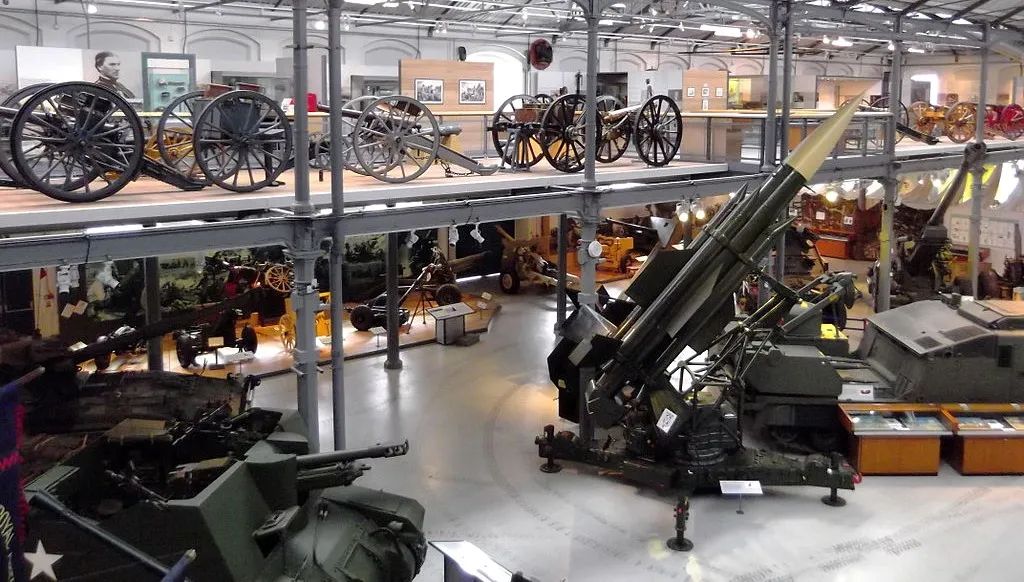
(David Holt Photo)
Part of the museum collection as presented in Firepower's Gunnery Hall, with 20th-century pieces on the ground floor and older items above.
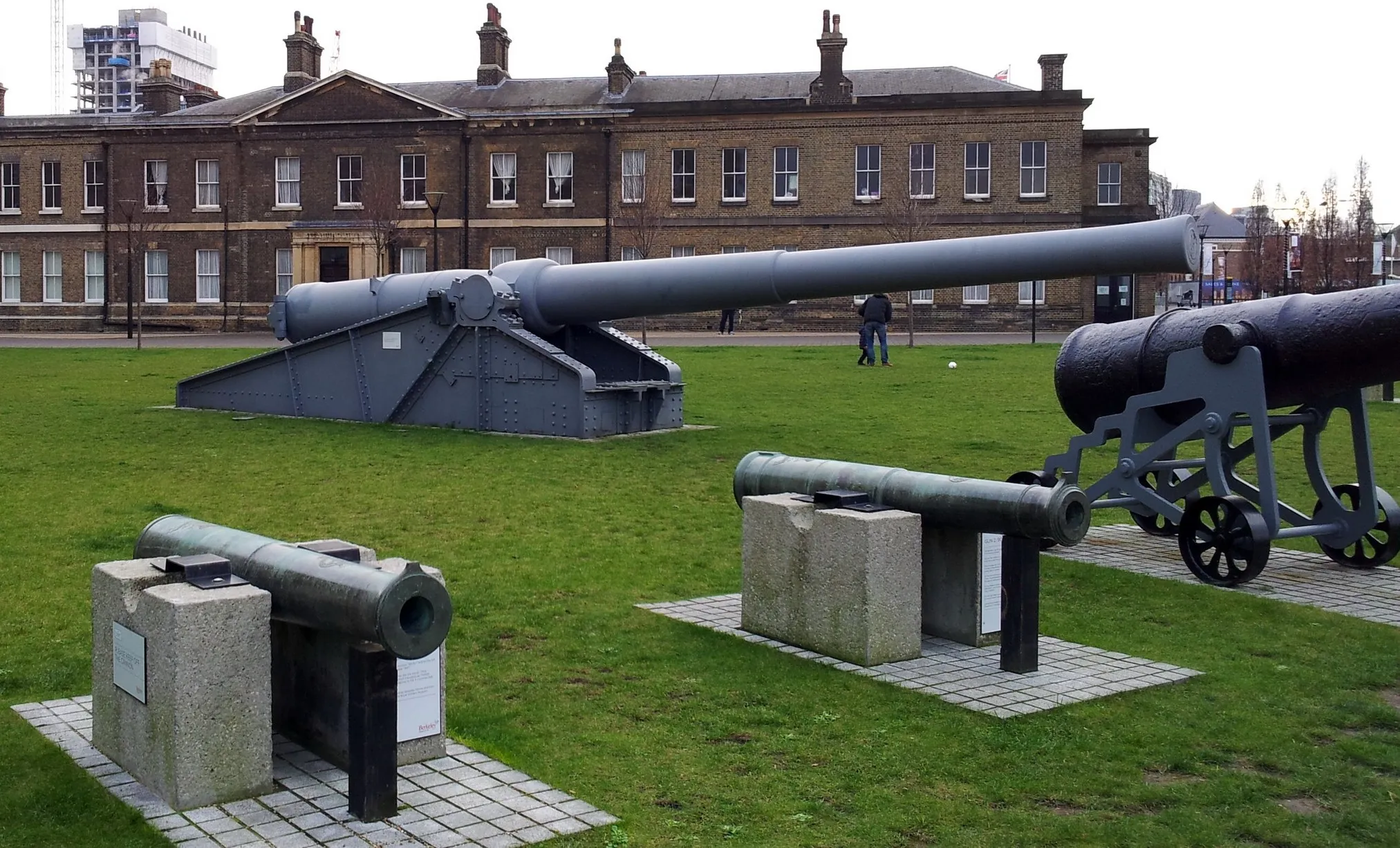
(Kleon3 Photo)
James Clavell Square in Royal Arsenal, Woolwich, South East London. In the background the Royal Artillery Museum.
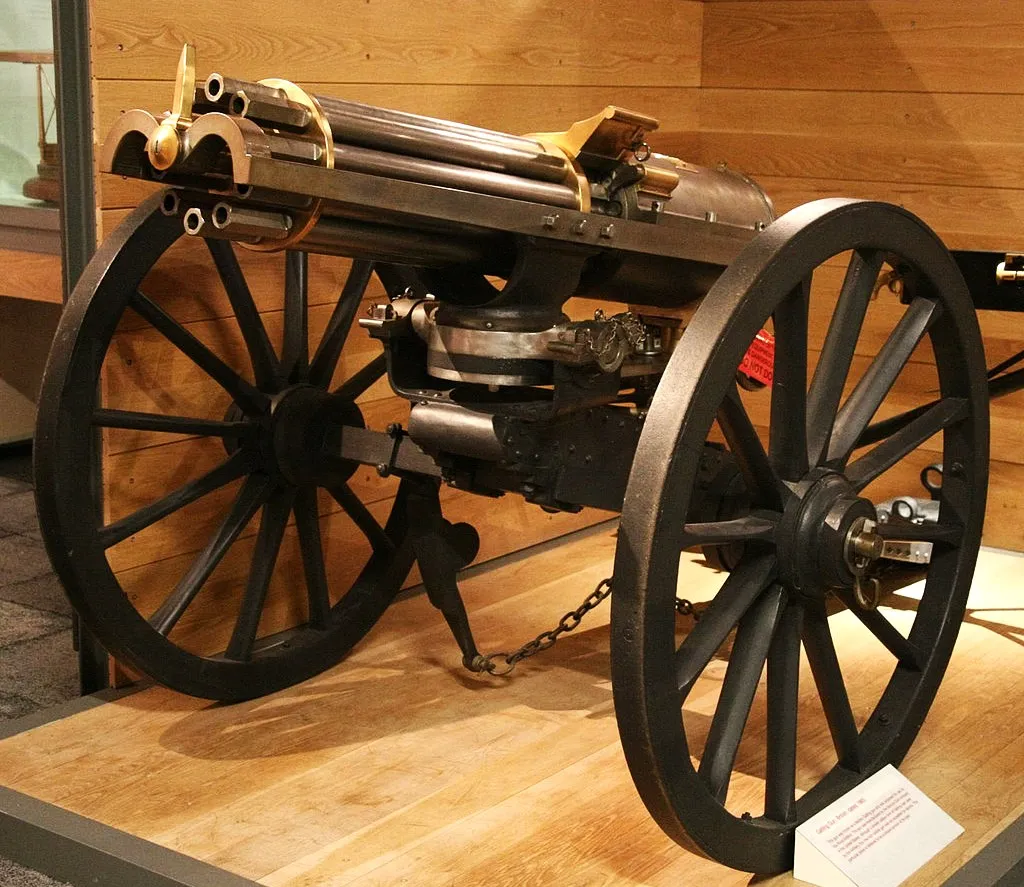
(Max Smith Photo)
Gatling Gun, 1865.

(Max Smith Photo)
FV433 Abbot self-propelled gun (SPG).
Dover Strait Coastal Guns
The Dover Strait coastal guns were long-range coastal artillery batteries that were sited on both sides of the English Channel during the Second World War. The British built several gun positions along the coast of Kent, England while the Germans fortified the Pas-de-Calais in occupied France. The Strait of Dover was strategically important because it is the narrowest part of the English channel. Batteries on both sides attacked shipping as well as bombarding the coastal towns and military installations. The German fortifications would be incorporated into the Atlantic Wall which was built between 1942 and 1944.
After the Fall of France in June 1940, Adolf Hitler personally discussed the possibility of invasion with Großadmiral (Grand Admiral) Erich Raeder, the Commander-in-Chief of the Kriegsmarine (German Navy) on 21 May 1940. Almost a month later on 25 June he ordered Oberkommando der Wehrmacht (OKW, supreme command of the armed forces) to begin preparation and feasibility studies, which had to be completed by 2 July, for the invasion of Britain. In an OKW directive on 10 July, operational coastal batteries under the control of the Kriegsmarine would support the invasion fleet.
From their establishment in August 1940 and for the following two years one out of every five Channel convoys was fired upon, with an average of 29 rounds on each occasion. no convoys at all were fired on 1943, though shelling resumed sporadically in 1944. During the whole period up to the Normandy landings no ship was hit, though some damage was done by near misses. Most of the batteries continued firing until September 1944 when they were overrun during the clearing of the Channel Coast. By then more than a thousand rounds had been fired by the German coastal batteries against England and shipping.
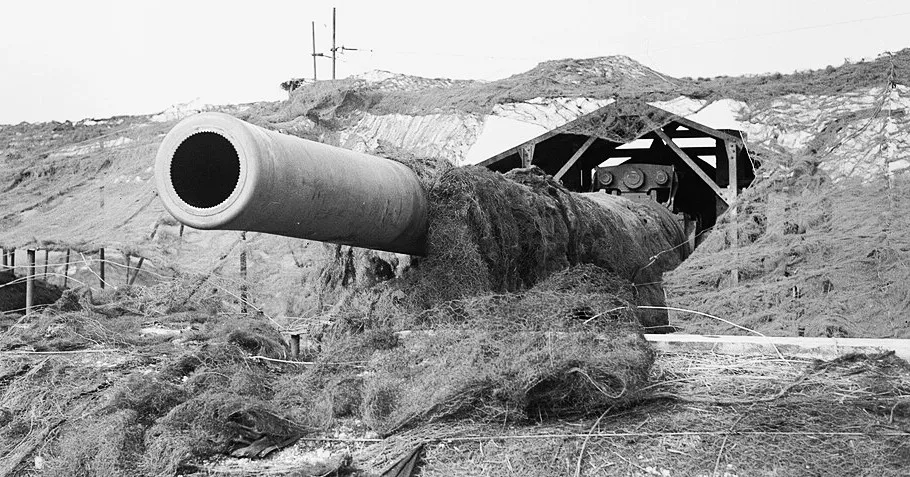
(IWM Phot H 7918)
'Winnie', one of two British 14-inch naval gun emplaced at St Margarets near Dover, 10 March 1941. This was the first gun, nicknamed 'Winnie' and manned by Royal Marines. 'Winnie', and it's sister gun 'Pooh', came from the reserve stock of guns for the 'King George V' class of battleships, and were mounted on modified naval barbettes. 'Winnie', named for the Prime Minister, was in place by August 1940 and 'Pooh' in February 1941. Manned by Royal Marine gunners, they were mostly employed in counter-battery fire with German batteries on the French coast.
Having withdrawn in the Dunkirk evacuation and winning the Battle of Britain, the British did not have an immediate answer to the threat posed by the German coastal batteries. However, the high ground to either side of the Port of Dover was fortified on the personal order of Prime Minister Winston Churchill (who had visited the area to see the situation in person) and wanted large calibre guns dug in there. The only British cross-Channel guns already in place were two BL 14 inch Mk VII (35.6 cm) guns Winnie (named after Churchill) and – later in 1940 – Pooh (named after the story book character Winnie the Pooh) at St Margaret's at Cliffe.[10] Both guns were spares taken from the stock of guns of the battleship HMS King George V. One gun used a mounting from HMS Furious, while the other had a mounting from a test range; neither was turret-mounted. Their separate and well-camouflaged cordite and shell magazines were buried under deep layers of earth and connected to the guns by railway lines. Both batteries were camouflaged and protected from aerial attack by anti-aircraft emplacements behind and below St. Margaret's.
Both guns were operated from separate firing-control rooms and were manned by 25-man troop of the Royal Marines Siege Regiment. Although Winnie fired Britain's first shell onto continental Europe in August 1940 boosting morale, the Mk VII naval guns were slow to reload and ineffectual compared to the German guns in the Pas-de-Calais. Both conducted extreme range counter-battery operations against the Germans' coastal guns but they were too inaccurate and slow to fire on enemy shipping.
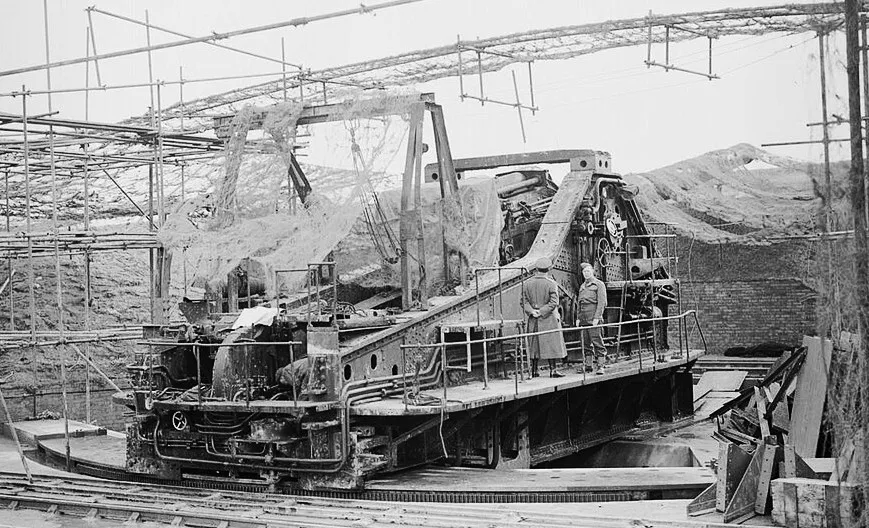
(IWM Photo, H 7922)
'Pooh', the second of two 14-inch guns emplaced at St Margaret's, near Dover, 10 March 1941. The first gun, named 'Winnie', was in place by August 1940 and 'Pooh' followed in February 1941. Both came from the reserve stock of guns for the 'King George V' class of battleships, and were mounted on modified naval barbettes. Manned by Royal Marine gunners, they were mostly employed in counter-battery fire with German batteries on the French coast.
Due to these guns' lack of success in targeting shipping, Churchill ordered three new heavy gun batteries to be built in Dover and manned by the Royal Artillery:
Three BL 6-inch (152 mm) Mk VII guns with a range of 25,000 yd (23,000 m), at Fan Bay Battery.
Four BL 9.2-inch (234 mm) Mks IX–X guns with a range of 31,000 yd (28,000 m) at South Foreland Battery.
Two BL 15-inch (381 mm) Mk I guns with a range of 42,000 yd (38,000 m) at Wanstone Battery, known as Clem (after Clement Attlee) and Jane (after the pin-up).
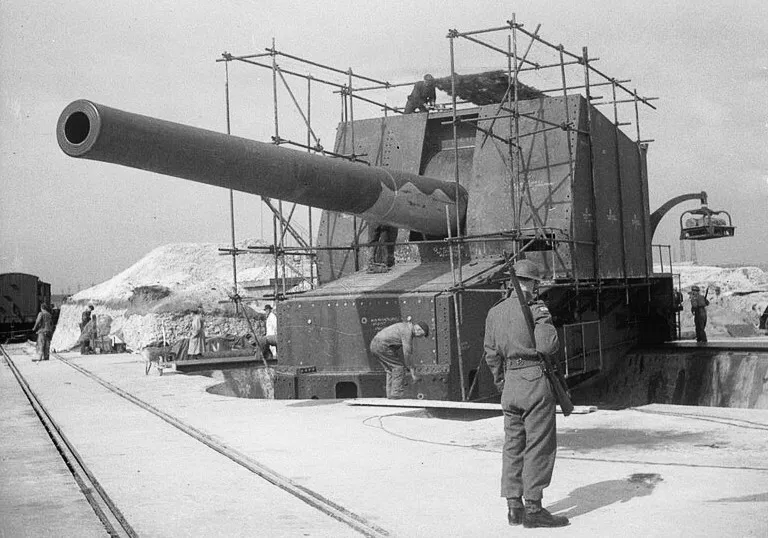
(IWM Photo, H 19833)
15-inch coastal gun of the Wanstone Battery, under construction at St Margarets near Dover, 18 May 1942.
The guns were later joined by Lydden Spout Battery, consisting of three more BL 6-inch Mk VII guns. Also, three BL 13.5-inch (343 mm) Mk. V naval guns from the First World War (named Gladiator, Scene Shifter and Piece Maker [sic]) were brought out of retirement in 1939 and mounted on railway chassis. (Wikipedia)
This gunnery duel, along with heavy German shelling and bombing of Dover Strait and the Dover area, led to this stretch of the Channel being nicknamed Hellfire Corner and led to 3,059 alerts, 216 civilian deaths and damage to 10,056 premises in the Dover area. British coastal convoys had to pass through the bottleneck of the Dover strait to transport supplies, particularly coal; Britain's road and rail network was not then able to cope with the volume of traffic that had to be handled. Although the German guns regularly fired on these slow moving convoys from 1940 to 1944, with an interlude in 1943, they only sank one ship though they damaged several others. Two seamen were killed and others were injured by shell splinters from near misses. However, the civilian crews of the merchant ships found the shelling more unnerving than the attacks by aircraft or E-boats that they were also subjected to and there were instances of crews refusing to sail from their forming-up point at Southend-on-Sea because of the German guns.
Many of the British batteries remained until the decision was taken to retire all the coastal artillery in 1956. The 15-inch guns at Wanstone Farm were not removed until 1959. The sites have either been demolished, buried or left to decay. At Wanstone Farm Battery, ancillary buildings such as the plotting room and the guard house are visible, although overgrown and the sergeants' mess has reverted to its original use as a farm house.
Royal Artillery Memorial
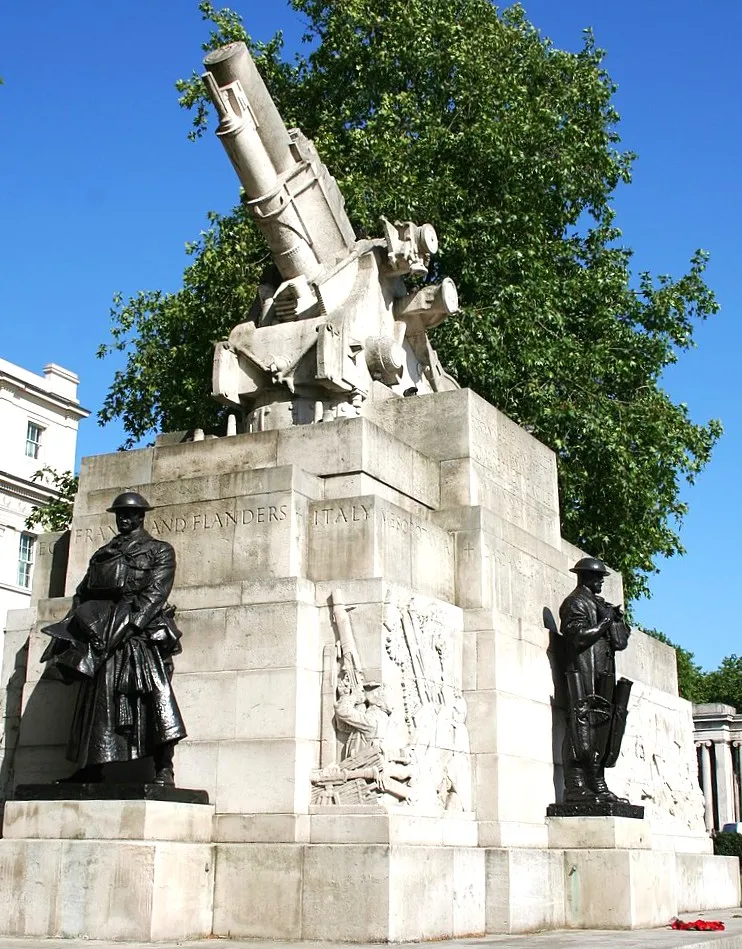
(Galileo55 (Michael Arrighi) Photo)
The Royal Artillery Memorial is a First World War memorial located on Hyde Park Corner in London, England. Designed by Charles Sargeant Jagger, with architectural work by Lionel Pearson, and unveiled in 1925, the memorial commemorates the 49,076 soldiers from the Royal Artillery killed in the First World War. The static nature of the conflict, particularly on the Western Front, meant that artillery played a major role in the war, though physical reminders of the fighting were often avoided in the years after the war. The Royal Artillery War Commemoration Fund (RAWCF) was formed in 1918 to preside over the regiment's commemorations, aware of some dissatisfaction with memorials to previous wars. The RAWCF approached several eminent architects but its insistence on a visual representation of artillery meant that none was able to produce a satisfactory design. Thus they approached Jagger, himself an ex-soldier who had been wounded in the war. Jagger produced a design which was accepted in 1922, though he modified it several times before construction.
The memorial consists of a Portland stone cruciform base supporting a one-third over-lifesize sculpture of a howitzer (a type of artillery field gun), which Jagger based on a gun in the Imperial War Museum. At the end of each arm of the cross is a sculpture of a soldier—an officer at the front (south side), a shell carrier on the east side, a driver on the west side, and at the rear (north) a dead soldier. The sides of the base are decorated with relief sculptures depicting wartime scenes. The realism of the memorial, with the depiction of the howitzer and the dead soldier, differed significantly from other First World War memorials, notably the influential Cenotaph, which used pure architectural forms and classical symbolism. The design was controversial when unveiled; some critics viewed the dead soldier as too graphic or felt that the howitzer did not lend itself to rendition in stone. Nonetheless, the memorial was popular with others, including ex-servicemen, and later came to be recognised as Jagger's masterpiece and one of Britain's finest war memorials.
The memorial was unveiled by Prince Arthur on 18 October 1925. Dedications were later added to the memorial in memory of the 29,924 Royal Artillerymen killed in the Second World War. It underwent restoration in 2011 after years of weathering and water ingress. The memorial is a Grade I listed building and is managed by English Heritage; it now shares its site with multiple other military monuments and war memorials. (Wikipedia)
.webp)
(Kazimierz Mendlik Photo)
The west side of the memorial, showing the over-lifesize howitzer, with the Wellington Arch in the background.





